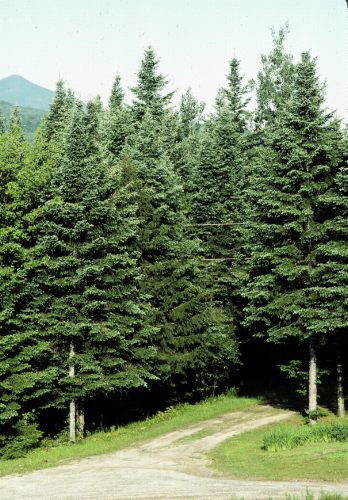Abies balsamea
Balsam Fir, Balm of Gilead
Pinaceae
ExpandHabitat
- native to most of northern United States and into Canada
- zone 3
Habit and Form
- evergreen tree
- 50' to 60' tall by 20' to 30' wide
- slender, conical shape
- fine to medium texture
- slow growth rate
Summer Foliage
- needles are variable, up to 1" long
- 2 lateral sets of leaves arranged horizontally, V-shaped parting between sets
- leaf tip is notched
- dark, shiny green with 2 white stomatal lines on underside
- buds are resinous
Autumn Foliage
- no fall color (evergreen)
Flowers
- no ornamental value
- monoecious
Fruit
- brown resinous cones
- cones shatter soon after maturing
- cones typically found only in upper third of the canopy
- 3" to 4" long
Bark
- dull green turning gray with age
- smooth bark with sporadic resin blisters, even on relatively old trunks
- new stems are smooth and covered with soft gray hairs
Culture
- easily transplanted because of shallow root system
- prefers cold climates
- well-drained, acidic soil
- dislikes heat and dry air
- not well-adapted to cultivation
Landscape Uses
- specimen tree
- widely used as Christmas tree
- bird and animal shelter
Liabilities
- loses nice "Christmas tree" shape with age
- problem pests and diseases include: spruce budworm, woolly aphid, and several cankers
- often performs poorly under landscape conditions
- often damaged by deer
ID Features
- two-ranked needles in a V-shape
- new stems covered with gray hairs
- circular leaf scars
- smooth bark with resin blisters
- notched needle tip
- resinous buds
Propagation
- by seed, stratification period required for good germination
Cultivars/Varieties
'Nana' and 'Hudsonia' - Various dwarf forms of this species are available from specialty dwarf conifer nurseries. The two listed here form small mounds to 2' tall and are suited to rockgardens and similar situations. Most dwarf forms are sterile.
